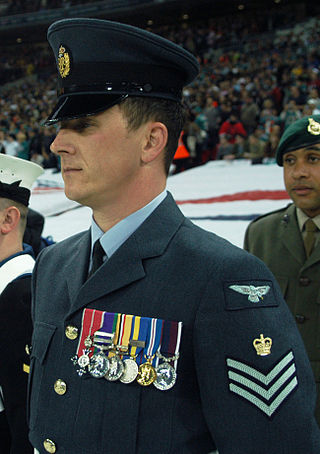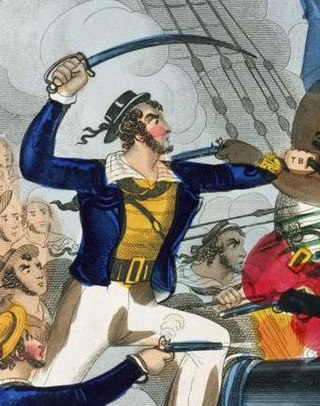
The British Army is the principal land warfare force of the United Kingdom, British Overseas Territories and Crown Dependencies, a part of the British Armed Forces along with the Naval Service and the Royal Air Force. As of 1 January 2024, the British Army comprises 75,166 regular full-time personnel, 4,062 Gurkhas, 26,244 volunteer reserve personnel and 4,557 "other personnel", for a total of 110,029.
Second lieutenant is a junior commissioned officer military rank in many armed forces. The lowest officer rank, it is usually placed below lieutenant or first lieutenant.

The Royal Military Academy Sandhurst, commonly known simply as Sandhurst, is one of several military academies of the United Kingdom and is the British Army's initial officer training centre. It is located in the town of Sandhurst, Berkshire, though its ceremonial entrance is in Camberley, Surrey, southwest of London. The academy's stated aim is to be "the national centre of excellence for leadership". All British Army officers, including late-entry officers who were previously Warrant Officers, as well as other men and women from overseas, are trained at the academy. Sandhurst is the British Army equivalent of the Britannia Royal Naval College and the Royal Air Force College Cranwell.
A Bangalore torpedo is an explosive charge placed within one or several connected tubes. It is used by combat engineers to clear obstacles that would otherwise require them to approach directly, possibly under fire. It is sometimes colloquially referred to as a "Bangalore mine", "banger" or simply "Bangalore" as well as a pole charge.
Lance corporal is a military rank, used by many English-speaking armed forces worldwide, and also by some police forces and other uniformed organisations. It is below the rank of corporal.

The Royal Military Police (RMP) is the corps of the British Army responsible for the policing of army service personnel, and for providing a military police presence both in the UK and while service personnel are deployed overseas on operations and exercises. Members of the RMP are often known as 'Redcaps' because of the scarlet covers on their peaked caps and scarlet coloured berets.

Flight sergeant is a senior non-commissioned rank in the Royal Air Force and several other air forces which have adopted all or part of the RAF rank structure. It is equivalent to a staff sergeant or colour sergeant in the British Army, a colour sergeant in the Royal Marines, and a chief petty officer in the Royal Navy, and has a NATO rank code of OR-7. In the RAF, flight sergeant ranks above chief technician and below warrant officer.

Wilkinson Sword is a formerly British brand for razors and other personal care products sold in Europe, owned by the US company Edgewell Personal Care. The company was founded as a manufacturer of guns made in Shotley Bridge in County Durham, by Henry Nock in London in 1772.
Physical training instructor (PTI) is a term used primarily in the British Armed Forces and British police, as well as some other Commonwealth countries, for an instructor in physical fitness.

The United Kingdom's Strategic Command (StratCom), previously known as Joint Forces Command (JFC), manages allocated joint capabilities from the three armed services.

The Fairbairn–Sykes fighting knife is a double-edged fighting knife resembling a dagger or poignard with a foil grip. It was developed by William Ewart Fairbairn and Eric Anthony Sykes in Shanghai based on ideas that the two men had while serving on the Shanghai Municipal Police in China before World War II.

The Pattern 1908 cavalry trooper's sword was the last service sword issued to the cavalry of the British Army. It has been called the most effective cavalry sword ever designed, although its introduction occurred as swords finally became obsolete as military weapons. In use, it, like other thrust-based cavalry swords, is best described as a one-handed lance, due to its complete lack of utility for anything but the charge. In fact, the closely related US Model 1913 Cavalry Saber was issued with only a saddle scabbard, as it was not considered to be of much use to a dismounted cavalryman. Colonial troops, who could expect to engage in melee combat with opposing cavalry frequently carried cut and thrust swords either instead of, or in addition to, the P1908/1912.

The gothic hilted swords were a family of swords carried by officers and some NCOs of the British Army between 1822 and the present day. They were primarily infantry swords, although they were also regulation pattern for some other officers such as surgeons and staff officers. The term "Gothic hilt" is derived from a perceived similarity between the curved bars of the guard and the arches found in Gothic architecture. They were elegant aesthetically pleasing weapons, although they were considered by some to be mediocre fighting swords. The weapon and its variants had a very long service life.
The 1897 pattern infantry officers’ sword is a straight-bladed, three-quarter basket-hilted sword that has been the regulation sword for officers of the line infantry of the British Army from 1897 to the present day.

The Sword of Stalingrad is a bejewelled ceremonial longsword specially forged and inscribed by command of King George VI of the United Kingdom as a token of homage from the British people to the Soviet defenders of the city during the Battle of Stalingrad. On 29 November 1943, it was presented to Marshal Joseph Stalin by British Prime Minister Winston Churchill at a ceremony during the Tehran Conference, in the presence of President Franklin D. Roosevelt and an honour guard.
The Firmin Sword of Peace is an award given to units of the British Armed Forces for activities above and beyond the unit's normal role that improve relations with the community, either within the United Kingdom, or overseas.
Major general is a military rank used in many countries. It is derived from the older rank of sergeant major general.

Ratings of the Royal Navy have used cutlasses, short, wide bladed swords, since the early 18th century. These were originally of non-uniform design but the 1804 Pattern, the first Navy-issue standard cutlass, was introduced at the start of the 19th century. This was a bluntish weapon that was perhaps intended for cutting away canvas and ropes rather than as a thrusting combat weapon. The 1845 Pattern cutlass introduced a bowl-style hand guard which provided greater protection, with a longer and more curved blade. Its sharper point made it more useful for thrusting attacks, which were now emphasised in the drill manual. The 1845 Pattern was modified several times including shortening and straightening the blades, which weakened them. The 1889 Pattern had a straight, spear-pointed blade with a hilt that curved outwards to catch and redirect an opponent's sword point. The 1900 Pattern, the last navy-issue cutlass, was similar to its predecessor with the introduction of a fuller and a hilt insert that cushioned the user's little finger. The cutlass was withdrawn from service in 1936 but remains in use for ceremonial purposes. It is thought that it was last used in combat in 1900 during the Boxer Rebellion.











